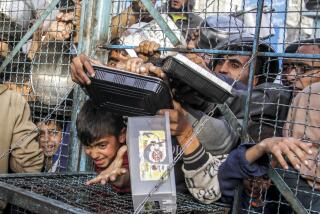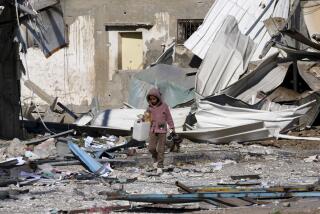A Medical Supplier Without Borders
- Share via
SANTA BARBARA — SANTA BARBARA -- Most international relief organizations subscribe to the adage that if you give a man a fish, you feed him once, but if you teach him to fish, you feed him for a lifetime.
Direct Relief International subscribes to a different theory: No matter how well you train someone to fish, he still needs a pole, bait and something to catch.
In the realm of international medicine, that means supplying trained doctors and clinicians in the world’s backwaters with the rudimentary materials they need to diagnose and treat common diseases.
“The thing is to keep the health professionals productively engaged, but also to directly help those [patients] who need it,” said Thomas Tighe, president of the 54-year-old nonprofit organization based in a 36,000-square-foot warehouse at Santa Barbara Municipal Airport.
“It’s a necessary complement to training people and giving them the skills to provide health services, and not have them be enormously frustrated because they can’t do their job.”
Last year, Direct Relief shipped 951,000 pounds of donated medical supplies and equipment--valued at $81.5 million--to more than 500 hospitals, clinics and doctors offices in some 60 Third World countries. While admitting that a full tally is impossible, the organization estimates that last year it helped more than 10 million people.
And, like an ant that can carry up to 20 times its own weight, the charity did it with a budget of $2.1 million, 17 full-time and eight part-time workers, and an army of more than 400 volunteers.
Projects range from finding and shipping 30 wheelchairs to a facility for disabled boys in Accra, Ghana, to sending patient-monitoring devices to a regional hospital overwhelmed after earthquakes destroyed all the other medical facilities in northwest Turkey.
Direct Relief’s current challenges--such as the wheelchair project--can be found scrawled in erasable marker on white board hanging in its warehouse headquarters.
Seven projects are detailed in red ink, which means a reliable recipient is in place somewhere in the world, the medical materials have been donated and money has been found to ship out everything from drugs to rudimentary operating tables.
Another 14 projects are in blue ink, indicating approved projects for which the organization is trying to find materials and the money to truck the supplies to the Port of Long Beach and ship them overseas.
Although most of the projects send supplies to generally safe parts of the world, others involve war zones. As Israeli tanks were rolling, Direct Relief was preparing to ship medical supplies, including eyeglasses, to a medical facility in a Palestinian section of Israel.
And in the months prior to the U.S. attacks on Afghanistan, Direct Relief supplied three medical facilities in Kabul with a wide range of material. After war broke out, it shifted its focus to border refugee camps, sending medicine and basic medical equipment. Now it is eyeing new aid to Kabul doctors.
Direct Relief’s role in Afghanistan went largely unnoticed in the United States, although Tighe said the headquarters fielded one anonymous call.
“There were several folks on the line, young men, and they were profanely criticizing our assistance to Afghanistan,” Tighe said. “There wasn’t a direct threat, but it was unsettling.”
Tighe also found the call frustrating: Direct Relief steers away from political stances, directing its aid to places where it is needed, and where it can verify that the material will aid civilians.
“They have to be ethical and nondiscriminatory in who they service, have a good reputation and are trained,” Tighe said.
Not all the work is focused overseas. Direct Relief is part of a regional response system in the event of disasters such as earthquakes, and is in the process of establishing a regional emergency repository of medicines, to be donated by Johnson & Johnson, one of its largest supporters.
Direct Relief also has sponsored dental clinics for local low-income families through the USC-UCLA mobile dental clinic.
But the vast majority of its work is foreign, a pattern established in 1945 when William Zimdin, an Estonian immigrant, began shipping food, clothing and medicines to help his homeland rebuild after World War II.
In 1948, the efforts were formalized in the William Zimdin Foundation, which became Direct Relief Foundation in 1957 under Dezso Karczag, a Hungarian immigrant who took over after Zimdin’s death in 1951. The current name was adopted in 1982.
Tighe took over Direct Relief less than two years ago after spending eight years in the Peace Corps, the last five as the agency’s top financial officer.
For Tighe, who had never heard of Direct Relief until the recruiter called, the transition has been refreshing. One key is the shift from a bureaucracy overseeing more than 7,000 Peace Corps volunteers to a small organization with a narrow but significant focus.
“I had a strong sense that their heart was in the right place,” he said. “This is private people and private business doing something altruistic for no other reason than what it purports to be.”
More to Read
Sign up for Essential California
The most important California stories and recommendations in your inbox every morning.
You may occasionally receive promotional content from the Los Angeles Times.











